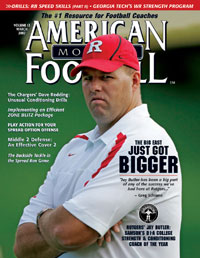AMERICAN FOOTBALL MONTHLY THE #1 RESOURCE FOR FOOTBALL COACHES
Article CategoriesAFM Magazine
|
Lightning Strikes San Diego Chargers\' Dave Redding\'s Unusual Methods to EffectSamson\'s NFL Strength & Conditioning Coach of the Yearby: Larry Hartstein © More from this issue STRATEGY San Diego’s Dave Redding, the 2006 Samson Strength and Conditioning NFL Coach of the Year, describes football as an “awkward movement sport.” And that description shapes his strategy on training the Chargers. “I could really care less what they bench, squat or power clean one time,” he said. “I don’t test them on that. I do test them on their ability to sustain a very intensive effort for two hours, four days a week, year round. The only thing that matters for me is that they’re ready for battle.” Playing in the NFL is a brutal experience, and Redding sees his job as preparing the Chargers for that abuse. “In football you go, you fall down, get up, accelerate off somebody, backpedal, and so on,” he said. “Only one time do you get to run in a perfectly straig....The full article can only be seen by subscribers. Subscribe today!
|
|
|||||||
| HOME |
MAGAZINE |
SUBSCRIBE | ONLINE COLUMNISTS | COACHING VIDEOS |
Copyright 2025, AmericanFootballMonthly.com
All Rights Reserved





